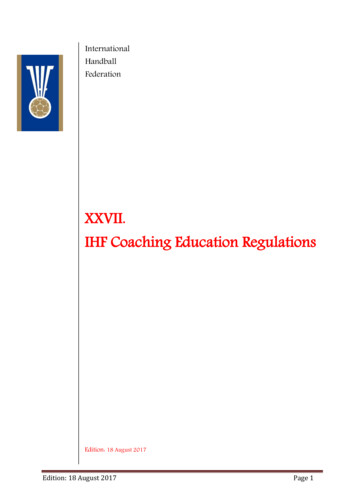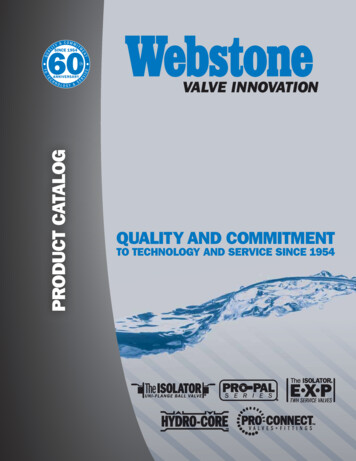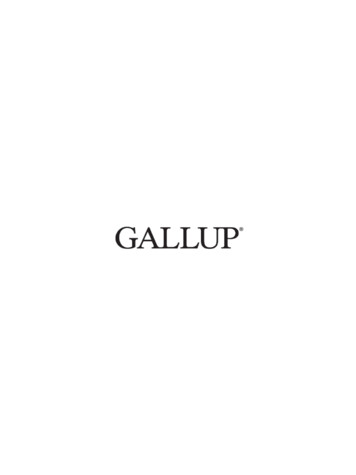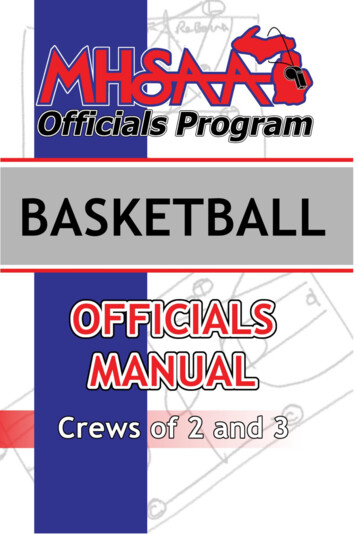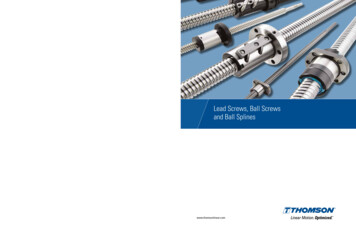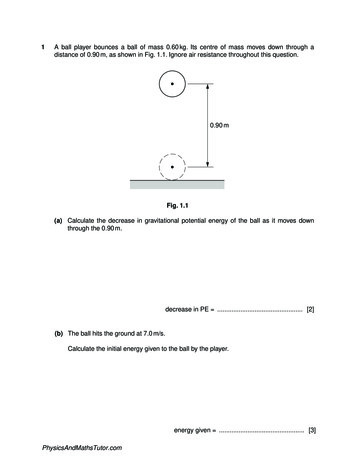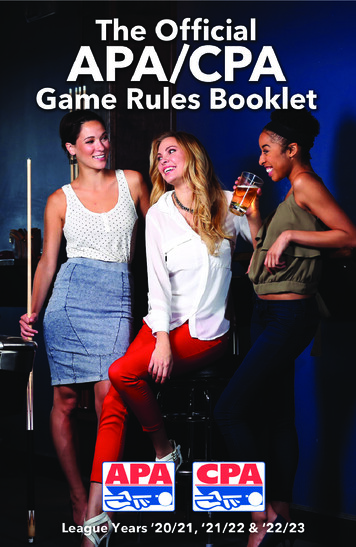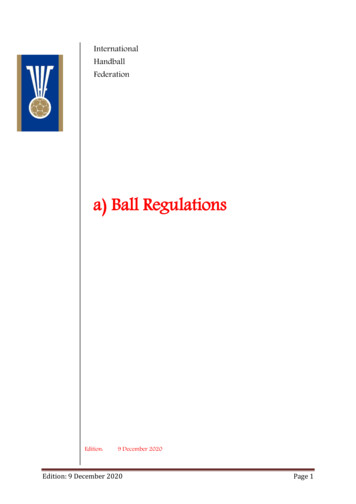
Transcription
InternationalHandballFederationa) Ball RegulationsEdition:9 December 2020Edition: 9 December 2020Page 1
Table of contents1.General Principles2.Technical Specifications for Handballs3.Special Specifications of Leather Handballs4.Special Specifications of Plastic Handballs5.IHF Seal of Approval6.Licence FeeAppendices1. Test Form2. Standard Contract3. IHF Handball Requirements and Test MethodsEdition: 9 December 2020Page 2
ARTICLE 1I.General PrinciplesThese Regulations are to define the IHF criteria for handballs which have to be met. In addition, thecriteria concerned apply for the handball to be provided with the IHF seal of approval.There are three categories of IHF approval:IHF APPROVED PRO: for all official IHF matches as well as other international and elite level nationalmatches.IHF APPROVED: for all elite level national matches.IHF Seal of Approval for Testing Purposes.ARTICLE 2II.Technical Specifications for Handballs2.1.Technical requirements according to Rule 3 of the Rules of the Game and Appendix 31. The handballs shall be produced of a leather or plastic casing. They must be round and the outermaterial must not be shiny or smooth.2. The following three different categories of handballs shall apply:a) Handballs played with resinThe following ball sizes (i.e. circumference and weight) shall be used for the different age categories: 58 to 60 cm in circumference and 425 to 475 g in weight (IHF size 3) for men’s senior andmen’s youth (aged 16 and older) players 54 to 56 cm in circumference and 325 to 375 g in weight (IHF size 2) for women’s senior,women’s youth (aged 14 and older) and men’s youth (aged 12 to 16) players 50 to 52 cm in circumference and 290 to 330 g in weight (IHF size 1) for women’s youth(aged 8 to 14) and men’s youth (aged 8 to 12) playersEdition: 9 December 2020Page 3
b) Handballs played without resinThe following ball sizes (i.e. circumference and weight) shall be used for the different age categories: 55.5 to 57.5 cm in circumference and 400 to 425 g in weight (IHF size 3) for men’s seniorand men’s youth (aged 16 and older) players 51.5 to 53.5 cm in circumference and 300 to 325 g in weight (IHF size 2) for women’ssenior, women’s youth (aged 14 and older) and men’s youth (aged 12 to 16) players 49 to 51 cm in circumference and 290 to 315 g in weight (IHF size 1) for women’s youth(aged 8 to 14) and men’s youth (aged 8 to 12) playersc) Handballs for beginnersFor beginners, different handballs may be used: 46 to 48 cm in circumference and 255 to 280 g in weight (IHF size 0) for children (aged 8and younger) or beginners of different age groups 44 to 46 cm in circumference and 165 to 190 g in weight (size 00) for children or otherbeginners 46 to 48 cm in circumference and 190 to 225 g in weight (non-inflatable squeeze balls) forchildren or other beginners 46 to 48 cm in circumference and 190 to 225 g in weight (non-inflatable sponge balls)Note: During use the handballs must retain their weight, shape and bouncing capacity.ARTICLE 3III.Special Specifications of Leather Handballs1. Leather balls must be made of high quality full-grained leather. After tanning, the leather must: have a high tensile and breaking strength (approximately 95kg/cm 2) be soft and supple to the touch have fault-free and resistant grains and seams which exclude all risk of injury and do notfray or split.2. The leather ball shall consist of at least 32 panels.3. Fully synthetic sewing threads shall be used.4. The bladders are made of latex or a similar, equivalent material with a stretching capacity of atleast 600%.5. The valve system of the bladder must be simple and effective to use.Edition: 9 December 2020Page 4
ARTICLE 4IV.Special Specifications of Plastic HandballsBall casings or bladders made of plastic must be a fully equivalent substitute for a leather casing orrubber bladder in every respect.ARTICLE 5V.IHF Seal of Approval5.1.Awarding the IHF seal of approval1. The IHF seal of approval may be awarded upon application to any ball manufacturer if themanufacturer fulfils the technical and financial requirements.2. The application shall be made in writing, with the necessary technical documentation, in English,French or German to the IHF Head Office.3. To allow the technical requirements to be checked, at least six balls of each type of ball shall besent, free of charge, to the IHF together with the application, while at least seven balls of each typeof ball shall be sent, free of charge, to the service provider of the IHF.4. A testing fee shall be charged for the inspection.5. The IHF reserves the right to withdraw the seal of approval for balls if technical defects identifiedon subsequent retesting are not eliminated or if financial commitments made are not fulfilled.6. The place of jurisdiction is Basle/Switzerland.7. Upon application, the IHF may award an IHF seal of approval to a ball manufacturer only for balltesting purposes in accordance with Article 21.1 of the IHF Statutes. The same applicationprocedure as indicated above shall be followed. In addition to the costs incurred in connectionwith the ball inspection as outlined above, all costs related to the season test as per Article 21.1 ofthe IHF Statutes shall be covered by the ball manufacturer.5.2.Identification of IHF approved ballsIHF approved balls must be clearly printed, in colour, with the official IHF logo and the designation‘IHF APPROVED PRO’, ‘IHF APPROVED’ or ‘IHF Seal of Approval for Testing Purposes’ as follows:Edition: 9 December 2020Page 5
a) Handballs played with resinb) Handballs played without resinc) Handballs played with/without resin for testing purposes5.3.Use of IHF approved balls1. Only balls with the IHF seal of approval may be used at official IHF competitions.2. A list of ball manufacturers with the IHF seal of approval is kept by the IHF Head Office and isavailable free of charge.ARTICLE 6VI.Licence Fee1. On payment of the licence fee following the approval of the IHF and the service provider of theIHF, the manufacturer gains the right to affix the IHF seal of approval to balls of the tested andapproved type. The licence takes the form of a contract valid for one year drawn up by the IHFHead Office.Edition: 9 December 2020Page 6
2. The licence fee shall be paid to the IHF bank account on conclusion of the contract.3. The contract shall be renewed upon request of the ball manufacturer and after IHF’s approval.Any renewal shall be subject to a new contract between the ball manufacturer and the IHF.Edition: 9 December 2020Page 7
Appendix 1TEST FORM FOR HANDBALLSManufacturer: . .Data:Article: .Circumference in cm:Weight in g:New:. .After use:. .Bouncing properties:. . .Notes to Articles 2 and 3 of the IHF Ball Regulations:2.1.1:. . . .2.1.2:. . . . .3.1:. . .3.2:. .3.4:. .3.5:. .Remarks concerning the awarding of the IHF seal of approval: . . . . . .Place / DateEdition: 9 December 2020 Name / Signature of examinerPage 8
Appendix 2STANDARD CONTRACT- BALLS -CONTRACTbetween theINTERNATIONAL HANDBALL FEDERATION, hereinafter named ‘IHF’,with its Head Office atPeter Merian-Strasse 23P.O. BoxCH-4002 BasleSwitzerlandand represented by.and.hereinafter named ‘Ball Manufacturer’,with its headquarters in.and represented by.Edition: 9 December 2020Page 9
§1Subject of the contractThe IHF shall grant the Ball Manufacturerthe IHF seal of approval for handballsand, in accordance with the IHF Ball Regulations,the right to imprint the balls it producesas mentioned under § 4 with the clear coloured imprint,containing the IHF logo andthe designation ‘IHF APPROVED PRO’, ‘IHF APPROVED’ or ‘IHF Seal of Approval for TestingPurposes’ as follows:a) Handballs played with resinb) Handballs played without resinc) Handballs played with/without resin for testing purposesA sample of the IHF logo shall be provided to the Ball Manufacturer, if necessary, at the time thecontract comes into force.Edition: 9 December 2020Page 10
In addition to the above-mentioned designations, the Ball Manufacturer is entitled to refer to the testreport produced by the service provider of the IHF regarding the testing of the balls concerned. Suchright may only be exercised from the issuance date of the test report by the service provider of theIHF until the end date of the granting of the IHF seal of approval. Shall the contract be renewed, inaccordance with § 6 of the present contract, the Ball Manufacturer may refer to the test reportduring up to three consecutive contracts, thus for a maximum of three years.In case the Ball Manufacturer wishes to renew the contract after the third consecutive contract hasexpired, a new report shall be produced by the service provider of the IHF.The reference must be made as follows:"Empa Test Report No. [corresponding test report number] dated [corresponding Empa test report’sissuance date]"The Ball Manufacturer is prohibited to use the logo of the service provider of the IHF.The stipulations in the IHF’s current Ball Regulations, which form an integral part of this contractand which both parties to the contract recognise in full, shall be authoritative.§2Obligations of the Ball Manufacturer1. The Ball Manufacturer must send the ball(s) to be tested to the IHF as well as to the serviceprovider of the IHF. Seven (7) balls, at least, of each type, if applicable, shall be provided to theservice provider of the IHF. One ball will be retained by the service provider of the IHF for archivepurposes. Six (6) balls, at least, of each type, if applicable, shall be provided to the IHF to conductthe ball grip test. One ball will be retained by the IHF for archive purposes.2. The Ball Manufacturer must provide the IHF with all relevant information/documentation inorder to conduct the testing of the balls. This information/documentation includes, but is notlimited to:§3Ball type and sizeBall nameBall Manufacturer’s name and addressLiabilityThe IHF as well as the service provider of the IHF shall be only liable for any damages resulting fromunlawful intent or gross negligence in performing their contractual obligations. The IHF shall not beliable for any damage that might result from a delay in communication between the IHF and the BallManufacturer. Furthermore, the IHF shall not be liable for any damage caused by the serviceprovider assigned by the IHF to conduct the testing of the balls. Any further liability is excluded tothe maximum extent permitted by the law applicable to this contract.Edition: 9 December 2020Page 11
§4Specification of ball typesThe rights listed under § 1 shall be granted only to the following ball types: .Should the Ball Manufacturer require the rights listed under § 1 for further products, an additionalcontract shall be necessary.§5Licence feeAccording to a decision of the IHF Executive Committee the annual licence fee has been set atCHF . (Swiss francs)for one year.The licence fee is payable upon the contract's conclusion and shall be paid into the following IHFbank account:Bank: Bank CIC (Schweiz) AG, 4001 BaselIBAN CHF: CH15 0871 0043 4600 5200 1IBAN EUR: CH85 0871 0043 4600 5200 2IBAN USD: CH58 0871 0043 4600 5200 3SIC / Clearing number: 08710SWIFT-BIC: CIALCHBBAccount holder: International Handball FederationOn payment of the licence fee following the approval of the IHF and the service provider of the IHF,the Ball Manufacturer gains the right to affix the official IHF seal of approval to balls of the testedand approved type(s).§6Duration of contractThis contract shall be valid for one year starting from the signing of the contract.The contract shall be renewed upon request of the Ball Manufacturer and after IHF’s approval. Anyrenewal shall be subject to a new contract between the Ball Manufacturer and the IHF.§7IHF’s duty to provide informationThe IHF shall display all balls mentioned in this contract in the section reserved for IHF seals ofapproval on the IHF official website’s marketing page.Edition: 9 December 2020Page 12
§8Termination of contractThe IHF shall have the possibility to terminate the contract if the Ball Manufacturer refers to the testreport of the service provider of the IHF without complying with the applicable terms mentioned in §1 and fails to correct this erroneous reference within 20 days after the IHF’s notification.The IHF shall have the possibility to terminate the contract, with immediate effect, in case the BallManufacturer misuses the IHF logo and/or uses the logo for other balls (different size, quality, andname etc.) than the approved one(s) and/or culpably breaches its obligations under this contract.The IHF shall have the possibility to terminate the contract, with immediate effect, in case the BallManufacturer’s reputation is in a way significantly and publicly damaged, giving the IHFcomprehensible reason to believe that this may threaten its reputation as well.§9LanguageSince English is the IHF’s first official language, contracts are only composed and interpreted inEnglish.§ 10MiscellaneousThe Ball Manufacturer may not assign or transfer this contract nor any rights or obligationshereunder without the prior written consent of the IHF.This contract constitutes the entire agreement between the Ball Manufacturer and the IHFconcerning the subject matter hereof. There do not exist any written or verbal amendments.Any alterations of this contract are void unless they are made in writing and signed by the IHF andthe Ball Manufacturer. This also applies to an agreement to waive this requirement.§ 11Place of jurisdictionAccording to Article 1.6 of the IHF Statutes, the IHF shall be subject to Swiss law. Therefore, thiscontract shall be governed and interpreted by Swiss law. The place of jurisdiction shall be Basle,Switzerland, where the IHF Head Office is located.In case of any disputes arising out of or in connection with this contract, the parties shall exert theirbest efforts and strive for an amicable settlement. If no such amicable settlement can be achieved,any dispute arising out of or in connection with this contract, including any question regarding itsexistence, validity or termination, shall be referred to and finally resolved by arbitration under theEdition: 9 December 2020Page 13
Procedural Rules of the CAS Code (Articles R27 et seq.). These Rules are deemed to be incorporatedby reference into this clause. The CAS shall act as an ordinary court of arbitration.This contract shall be drawn up in duplicate.This contract shall come into effect immediately upon signing by the two parties.Place and date .INTERNATIONAL HANDBALL FEDERATIONSignature.Name.Function.Ball ManufacturerSignature.Name.Function.Edition: 9 December 2020Page 14
Appendix 3IHF Handball Requirements and Test Methods1. General PrinciplesThe IHF Handball Requirements and Test Methods define the requirements and test methods forhandballs to be provided with the IHF seal of approval.There are two categories of IHF approval:IHF APPROVED PRO: for all official IHF matches as well as other international and elite level nationalmatches.IHF APPROVED: for all elite level national matches.2. Test RequirementsThe following table indicates the requirements that must be met for a handball to be eligible forcertification:Inspection ItemHandball with RESINAPPROVED PROAPPROVEDHandball without RESINAPPROVED PROAPPROVEDCircumferencesize3 : 58-60cmsize2 : 54-56cmsize1 : 50-52cmsize3 : 58-60cmsize2 : 54-56cmsize1 : 50-52cmsize3 : 55.5-57.5cmsize2 : 51.5-53.5cmsize1 : 49-51cmsize3 : 55.5-57.5cmsize2 : 51.5-53.5cmsize1 : 49-51cmWeightsize3 : 425-475gsize2 : 325-375gsize1 : 290-330gsize3 : 425-475gsize2 : 325-375gsize1 : 290-330gsize3 : 400-425gsize2 : 300-325gsize1 : 290-315gsize3 : 400-425gsize2 : 300-325gsize1 : 290-315g90-110 cm90-110 cm90-110 cmRebound Height 90-110 cmSphericityless than 2.5%Size Retentionless than 1%Shape Retentionless than 2.5%Ball Gripplayable in dryconditionless than 2%playable in dryconditionless than 2.5%less than 1%less than 2.5%Playable both in dryand wet conditionless than 2%Playable both in dryand wet condition3. Test Methods3.1. Test ConditionsThe ambient conditions during testing shall be room temperature of 20 2 C, relative humidity of65 5% and atmospheric pressure of 860 to 1,060 hPa.Edition: 9 December 2020Page 15
3.2. Testing Ball PressureThe handballs are inflated with compressed air to the mean value of the range indicated by themanufacturer and clearly printed on the ball, i.e. manufacturer stated range is 0.10 to 0.20 bar,inflation pressure is 0.15 bar.- The range of the inflation pressure indicated by the manufacturer shall be clearly printed on theball.- The difference between minimum and maximum inflation pressure indicated by the manufacturershall be 0.10 bar or less.3.3. ConditioningThe handballs are inflated to a testing pressure as per 3.2. After conditioning at 20 2 C and 65 5% RH for at least 24h, the pressure is measured again and if necessary adjusted to testing pressure.3.4. CircumferenceAfter conditioning, the radius is measured by the CSM machine. Circumference is calculatedautomatically.Test apparatusCSM machineNumber of handballs tested3 per typeNumber of points measured4,500 (45 cycles 100 radii each)3.5. WeightAfter conditioning, the weight is measured by an electronic scale with an accuracy of 0.01g.Number of handballs tested3 per type3.6. Rebound HeightAfter conditioning, the rebound height is measured from the rebound surface to the bottom of thehandball when dropped from a height of 200 cm, measured to the bottom of the ball.Empa Test:A conditioned handball is dropped in a guided free fall with a defined velocity onto a plane steelsurface. With the help of a video camera, the height of rebound, at the lower side of the ball, isdetermined. The parallax error caused by the difference in the height of rebound and the cameraheight will be taken into account in the final results.End velocityNumber of samplesEdition: 9 December 20206.25 0.15 m/s(corresponds to a falling height of 2 m)3 per typePage 16
3.7. SphericityAfter conditioning, the radius is measured by the CSM machine. Sphericity is calculatedautomatically.Test apparatusCSM machineNumber of handballs tested3 per typeNumber of points measured4,500 (45 cycles 100 radii each)3.8. Shape and Size RetentionThe handballs are inflated to a defined pressure and shot against a steel plate with a fixed angle at adefined velocity. After a defined number of shots, the sphericity and increase in circumference aredetermined, and any damage to seams or valve is noted.Test apparatusspecial test apparatus (Empa)Number of shots1,000 for each handballNumber of handballs testedShot velocity3 per typeapprox. 50 km/h3.9. Ball GripThe grip of the handball is tested and evaluated by male and female players. This player test isarranged by the IHF Technical Committee.Number of handballs tested3 per type*A scientific test method to measure the ball grip is currently being reviewed by Empa. If developedsuccessfully, it may be added to the laboratory test items.Note: The IHF Handball Requirements and Test Methods shall be effective immediately. Those seals ofapproval awarded by the IHF according to the previous handball specifications shall be valid until31 December 2020.Edition: 9 December 2020Page 17
1. The Ball Manufacturer must send the ball(s) to be tested to the IHF as well as to the service provider of the IHF. Seven (7) balls, at least, of each type, if applicable, shall be provided to the service provider of the IHF. One ball will be retained by the service provider of the IHF for archive purposes.
